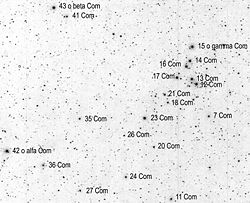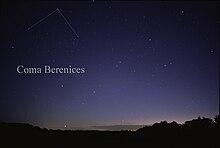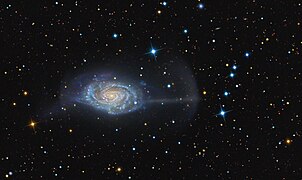Coma Berenices
| Constellation | |
42nd) | |
| Main stars | 3 |
|---|---|
| Bayer/Flamsteed stars | 44 |
| Stars with planets | 5 |
| Stars brighter than 3.00m | 0 |
| Stars within 10.00 pc (32.62 ly) | 1 |
| Brightest star | β Com (4.26m) |
| Messier objects | 8 |
| Meteor showers | Coma Berenicids |
| Bordering constellations | Canes Venatici Ursa Major Leo Virgo Boötes |
| Visible at latitudes between +90° and −70°. Best visible at 21:00 (9 p.m.) during the month of May. | |
Coma Berenices is an ancient
The constellation's major stars are
History

Coma Berenices has been recognized as an

Coma Berenices became popular during the 16th century. In 1515, a set of gores by Johannes Schöner labelled the asterism Trica, "hair". In 1536 it appeared on a celestial globe by Caspar Vopel, who is credited with the asterism's designation as a constellation.[12] That year, it also appeared on a celestial map by Petrus Apianus as "Crines Berenices". In 1551, Coma Berenices appeared on a celestial globe by Gerardus Mercator with five Latin and Greek names: Cincinnus, caesaries, πλόκαμος, Berenicis crinis and Trica. Mercator's reputation as a cartographer ensured the constellation's inclusion on Dutch sky globes beginning in 1589.[13]
Before the 18th century Coma Berenices was known in English by several names, including "Berenice's Bush" and "Berenice's periwig".[15] The earliest-known English name, "Berenices haire", dates to 1601.[15][16] By 1702 the constellation was known as Coma Berenices,[17] and appears as such in the 1731 Universal Etymological English Dictionary.
Non-Western astronomy
Coma Berenices was known to the
In Arabic astronomy Coma Berenices was known as Al-Dafira الضفيرة ("braid"), Al-Hulba الهلبة and Al-Thu'aba الذؤابة (both meaning "tuft"), the latter two are translations of the Ptolemaic Plokamos, forming the tuft of the constellation Leo[11] and including most of the Flamsteed-designated stars (particularly 12, 13, 14, 16, 17, 18 and 21 Comae Berenices).[21] Al-Sufi included it in Leo. Ulugh Beg, however, regarded Al-Dafira as consisting of two stars, 7 and 23 Comae Berenices.[22]
The North American Pawnee people depicted Coma Berenices as ten faint stars on a tanned elk-skin star map dated to at least the 17th century.[23] In the South American Kalina mythology, the constellation was known as ombatapo (face).[24]
The constellation was also recognized by several
Characteristics
Coma Berenices is bordered by Boötes to the east, Canes Venatici to the north, Leo to the west and Virgo to the south. Covering 386.5 square degrees and 0.937% of the night sky, it ranks 42nd of the 88 constellations by area.[28] The three-letter abbreviation for the constellation, as adopted by the International Astronomical Union in 1922, is "Com".[29] The official constellation boundaries, as set by Belgian astronomer Eugène Delporte in 1930,[b] are defined by a polygon of 12 segments (illustrated in infobox). In the equatorial coordinate system, the right ascension coordinates of these borders lie between 11h 58m 25.09s and 13h 36m 06.94s, and the declination coordinates are between +13.30° and +33.31°.[1] Coma Berenices is wholly visible to observers north of latitude 56°S.[c] and the constellation's midnight culmination occurs on 2 April.[31]
Features

Although it is not large, Coma Berenices contains one galactic
Stars
Brightest stars

Coma Berenices is not particularly bright, as none of its stars are brighter than fourth magnitude,[32] although there are 66 stars brighter than or equal to apparent magnitude 6.5.[d][28]
The constellation's brightest star is
The second-brightest star in Coma Berenices is the 4.3-magnitude, bluish
Gamma Comae Berenices (15 Comae Berenices) is an orange-hued giant star with a magnitude of 4.4 and a spectral class of K1III C. In the southwestern part of the constellation, it is 169 ± 2 light-years from Earth,[41] Estimated to be around 1.79 times as massive as the Sun,[42] it has expanded to around 10 times its radius.[43] It is the brightest star in the Coma Star Cluster.[44] With Alpha Comae Berenices and Beta Comae Berenices, Gamma Comae Berenices forms a 45-degree isosceles triangle from which Berenice's imaginary tresses hang.
Star systems
The
There are over thirty double stars in Coma Berenices,[49] including 24 Comae Berenices with contrasting colors. Its primary is an orange-hued giant star with a magnitude of 5.0, 610 light-years from Earth, and its secondary is a blue-white-hued star with a magnitude of 6.6. Triple stars include 12 Comae Berenices, 17 Comae Berenices, KR Comae Berenices and Struve 1639.[50][51]
Variable stars
Over 200
In 2019 scientists at Aryabhatta Research Institute of Observational Sciences announced the discovery of 28 new variable stars in Coma Berenices' globular cluster NGC 4147.[61]
Supernovae
A number of
Other stars
Coma Berenices also contains the neutron star RBS 1223 and the pulsar PSR B1237+25.[66] RBS 1223 is a member of the Magnificent Seven, a group of young neutron stars.[67] In 1975, the first extra-solar source of extreme ultraviolet, the white dwarf HZ 43, was discovered in Coma Berenices.[68] In 1995, there was a very rare outburst of the WZ Sagittae-type dwarf nova AL Comae Berenices.[69] A June 2003 outburst from GO Comae Berenices, an SU Ursae Majoris-type dwarf nova, was photometrically observed.[70]
Exoplanets
Coma Berenices has seven known
Star clusters
Coma Star Cluster
The Coma Star Cluster represents Berenice's sacrificed tresses and as a naked eye object has been known since antiquity, appearing in Ptolemy's Almagest.[74] It doesn't have a Messier or NGC designation, but is in the Melotte catalogue of open clusters (designated Melotte 111) and is also catalogued as Collinder 256. It is a large, diffuse open cluster of about 50 stars ranging between magnitudes five and ten, including several of Coma Berenices' stars which are visible to the naked eye. The cluster is spread over a huge region (more than five degrees across) near Gamma Comae Berenices. It has such a large apparent size because it is relatively close, only 280 light-years or 86 parsecs away.[75][76]
Globular clusters
M53 (NGC 5024) is a globular cluster which was discovered independently by Johann Elert Bode in 1775 and Charles Messier in February 1777; William Herschel was the first to resolve it into stars.[57] The magnitude-7.7 cluster is 56,000 light-years from Earth. Only 1° away is NGC 5053, a globular cluster with a sparser nucleus of stars. Its total luminosity is the equivalent of about 16,000 suns, one of the lowest luminosities of any globular cluster. It was discovered by William Herschel in 1784. NGC 4147 is a somewhat dimmer globular cluster, with a much-smaller apparent size and an apparent magnitude of 10.7.[77]
Galaxies
Coma Supercluster
The
Virgo Cluster

Coma Berenices contains the northern portion of the Virgo Cluster (also known as the Coma–Virgo Cluster), about 60 million light-years away. The portion includes six Messier galaxies. M85 (NGC 4382), considered elliptical or lenticular, is one of the cluster's brighter members at magnitude nine. M85 is interacting with the spiral galaxy NGC 4394 and the elliptical galaxy MCG-3-32-38.[66] However, it is relatively isolated from the rest of the cluster.[85] M88 (NGC 4501) is a multi-arm spiral galaxy seen at about 30° from edge-on. It has a highly-regular shape with well-developed, symmetrical arms. Among the first galaxies recognized as spiral,[86] it has a supermassive black hole in its center.[66] M91 (NGC 4548), a barred spiral galaxy with a bright, diffuse nucleus, is the faintest object in Messier's catalog at magnitude 10.2.[87] M98 (NGC 4192), a bright, elongated spiral galaxy seen nearly edge-on, appears elliptical because of its unusual angle. The magnitude-10 galaxy has no redshift.[88] M99 (NGC 4254) is a spiral galaxy seen face-on. Like M98 it is of magnitude-10 and has an unusually long arm on its west side. Four supernovae have been observed in the galaxy.[89][90][91] M100 (NGC 4321), a magnitude-nine spiral galaxy seen face-on, is one of the cluster's brightest.[59] Photographs reveal a brilliant core, two prominent spiral arms, an array of secondary arms and several dust lanes.
Other galaxies

M64 (NGC 4826) is known as the
NGC 4314 is a face-on barred spiral galaxy at a distance of 40 million light-years. It is unique for its region of intense star formation, creating a ring around its nucleus which was discovered by the Hubble Space Telescope. The galaxy's prodigious star formation began five million years ago, in a region with a diameter of 1,000 light-years. The core's structure is also unique because the galaxy has spiral arms which feed gas into the bar.[83]
Spiral galaxy
In 2006 a
-
NGC 4565 (Needle Galaxy)
-
NGC 4651, with umbrella-shaped stellar streams
-
The constellation Coma Berenices hosts the galaxy NGC 4495 among myriad other astronomical objects.
-
The jellyfish galaxy JW39 hangs serenely in this image from the NASA/ESA Hubble Space Telescope. This galaxy lies over 900 million light-years away in the constellation Coma Berenices.
Quasars
HS 1216+5032 is a bright, gravitationally lensed pair of quasars.[105] W Comae Berenices (or ON 231), a blazar in the constellation's northwest, was originally designated a variable star and later found to be a BL Lacertae object.[106] As of 2009, it had the most intense gamma ray spectrum of the sixty known gamma-ray blazars.[106]
Gamma-ray bursts
Some gamma-ray bursts occurred in Coma Berenices, particularly GRB 050509B on 9 May 2005[107] and GRB 080607 on 7 June 2008.[108] GRB 050509B, which lasted only 0.03 second, became the first short burst with a detected afterglow.[107]
Meteor shower
The Coma Berenicids meteor shower peaks around 18 January.[52] Despite the shower's low intensity (averaging one or two meteors per hour) its meteors are some of the fastest, with speeds up to 65 kilometres per second (40 mi/s).[52]
In culture

Since Callimachus' poem, Coma Berenices has been occasionally featured in culture. Alexander Pope alludes to the legend in the ending of The Rape of the Lock, in which the titular hair is placed among the stars. (The poem would go on to provide the names of some of the moons of Uranus.) In 1886, Spanish artist Luis Ricardo Falero created a mezzotint print personifying Coma Berenices alongside Virgo and Leo.[109] In 1892, the Russian poet Afanasy Fet made the constellation the subject of his short poem, composed for the Countess Natalya Sollogub.[110] The Swedish poet Gunnar Ekelöf wrote the lines "Your friend the comet combed his hair with the Leonids / Berenice let her hair hang down from the sky" in a 1933 poem.[111] American writer and folksinger Richard Fariña mentions Coma Berenices in his 1966 novel Been Down So Long It Looks Like Up To Me, sardonically writing about content typical to upper-level astronomy coursework at Cornell: "It's the advanced courses give you trouble. Relativity principles, spiral nebula in Coma Berenices, that kind of hassle". The Bolivian poet, Pedro Shimose, makes Coma Berenices the home address of his "Señorita NGC 4565" in his poem "Carta a una estrella que vive en otra constelación" ("Letter to a star who lives in another constellation"), included in his 1967 collection, "Sardonia".[112] "[113] The Irish poet W. B. Yeats, in his poem "Her Dream", refers to "Berenice's burning hair" being "nailed upon the night". Francisco Guerrero, a 20th-century Spanish composer, wrote an orchestral work on the constellation in 1996. In 1999 Irish artist Alice Maher made a series of four oversize drawings, entitled Coma Berenices, of entwining black hair coils.[114]
Notes
- ^ One other constellation's name is derived from a reference to a historical person: the constellation Scutum is a shortening of the former name Scutum Sobiescianum ("shield of Sobieski"), named for King John III Sobieski of Poland. It is called the equivalent of "Shield of Sobieski" in some other languages, such as French.
- ^ Delporte had proposed standardising the constellation boundaries to the International Astronomical Union, who had agreed and gave him the lead role[30]
- ^ While parts of the constellation technically rise above the horizon to observers between 56°S and 77°S, stars within a few degrees of the horizon are to all intents and purposes unobservable.[28]
- ^ Objects of magnitude 6.5 are among the faintest visible to the unaided eye in suburban–rural transition night skies.[33]
See also
References
- ^ a b c "Coma Berenices, constellation boundary". The Constellations. International Astronomical Union. Retrieved 27 February 2014.
- ^ "Coma Berenices". The American Heritage Dictionary of the English Language (5th ed.). HarperCollins.
- ^ a b c Pasachoff, Jay M. (2006). Stars and Planets. Boston, Massachusetts: Houghton Mifflin.
- ^ Van Oppen de Ruiter 2015, p. 109.
- ^ Gaius Julius Hyginus (1589). "2.24". Astronomica. [Heidelbergae] In Officina Sanctandreana.
- ^ ISBN 978-3-319-27619-9.
- ISBN 978-1-137-49462-7.
- ^ a b Ley, Willy (December 1963). "The Names of the Constellations". For Your Information. Galaxy Science Fiction. pp. 90–99.
- ISBN 978-0-19-960969-7.
- ISBN 0-521-59889-3.
- ^ a b Kunitzsch, Paul (2002). "Albumasariana" (PDF). Annali Istituto Universitario Orientale di Napoli. OPAR L'Orientale Open Archive. p. 4. Retrieved 6 November 2016.
- ^ Ridpath, Ian. "Coma Berenices". Star Tales. Retrieved 11 April 2012.
- ^ a b Dekker, Elly. "Caspar Vopel's Ventures in Sixteenth-Century Celestial Cartography". Atlas Coelestis. Retrieved 15 Aug 2016.
- ISBN 978-0-8153-0322-0.
- ^ a b Allen, Richard Hinckley. "Star Names Their Lore and Meaning". LacusCurtius. Retrieved 19 July 2016.
- ^ "Berenice". Online Etymology Dictionary. Retrieved 19 July 2016.
- ^ Leybourn, William; Morden, Robert (1702). An Introduction to Astronomy, Geography, Navigation and Other Mathematical Sciences, Made Easie by the Description and Uses of the Coelestial and Terrestrial Globes. R. Morden. p. 30.
- ISBN 0-931464-86-2.
- ^ E. Reiner; D. Pingree (1985). "Babylonian Planetary Omens. Part Two. Enūma Anu Enlil Tablets 50–51" (PDF). Undena Publications. Archived from the original (PDF) on 16 August 2016. Retrieved 10 July 2016.
- ^ José Lull; Juan Antonio Belmonte. "In Search of Cosmic Order: Selected Essays on Egyptian Archaeoastronomy" (PDF). Instituto de Astrofísica de Canarias. p. 177.
- ^ "The Tail Hair". Two Deserts One Sky. Retrieved 6 November 2016.
- ^ Royal Astronomical Society (1843). Memoirs of the Royal Astronomical Society. Vol. 14–15. p. 191.
- ^ Ralph N. Buckstaff (1927). "Stars and Constellations of a Pawnee Sky Map". American Anthropologist. Vol. 29, no. 2. p. 282.
- ISBN 0-226-47487-9.
- Bibcode:1941msra.book.....M.
- ISBN 978-94-011-4179-6.
- ^ Slovenská akadémia vied. Kabinet orientalistiky (1999). Asian and African Studies. Vol. 8. Veda. p. 32.
- ^ a b c Ridpath, Ian. "Constellations: Andromeda–Indus". Star Tales. self-published. Retrieved 26 August 2015.
- Bibcode:1922PA.....30..469R.
- ^ Ridpath, Ian. "Constellation boundaries: How the modern constellation outlines came to be". Star Tales. self-published. Retrieved 1 June 2016.
- ISBN 978-0-596-52685-6.
- ^ "Волосы Вероники" (in Russian). Pushchino Radioastronomic Observatory. Retrieved 20 July 2016.
- ^ Bortle, John E. (February 2001). "The Bortle Dark-Sky Scale". Sky & Telescope. Archived from the original on 2012-12-16. Retrieved 28 August 2017.
- .
- ^ "bet Com". SIMBAD. Centre de données astronomiques de Strasbourg. Retrieved 19 November 2016.
- ^ S2CID 18993744.. See Table 10.
- S2CID 18775378. Note: see VizieR catalogue J/ApJS/168/297.
- ^ "Naming Stars". IAU.org. Retrieved 16 July 2022.
- ^ "alf Com". SIMBAD. Centre de données astronomiques de Strasbourg. Retrieved 22 November 2016.
- S2CID 18759600.
- .
- S2CID 118505114.
- Accessed on line October 12, 2010.
- ^ Joerg S. Schlimmer (January 1, 2014). "Discovery of Small Companions of Comae and TYC 1989-00307-1 in Constellation Coma Berenices and a Possible New Common Proper Motion Pair in the Constellation Canes Venatici" (PDF). Journal of Double Star Observations. Retrieved 25 November 2016.
- ISBN 978-1-139-49522-6.
- .
- ISBN 978-0-486-31793-9.
- ^ "Atlas of O-C Diagrams of Eclipsing Binary Stars". Mt. Suhora Astronomical Observatory. Retrieved 6 November 2016.
- ^ "Double Stars in Coma Berenices". Eagle Creek Observatory. Archived from the original on 25 November 2016. Retrieved 6 November 2016.
- ^ Garfinkle 1997, pp. 127–128.
- S2CID 118435158. Retrieved 24 November 2016.
- ^ a b c d Tammy Plotner (24 Dec 2015). "Coma Berenices". Universe Today. Retrieved 15 Aug 2016.
- AAVSO. January 16, 2015. Retrieved 24 November 2016.
- S2CID 118705220.
- ISBN 0-7503-0654-8.
- ^ "Coma Berenices". RR Lyrae stars: the GEOS maxima database. 11 March 2008. Retrieved 22 November 2016.
- ^ a b "Messier 53". The Messier Catalog. Retrieved 24 November 2016.
- Bibcode:2016JAVSO..44...18D.
- ^ a b "Messier 100". The Messier Catalog. Retrieved 24 November 2016.
- ^ Garfinkle 1997, p. 127.
- ^ "Indian scientists discover 28 new Milky Way stars". Hindustan Times. 27 July 2019. Retrieved 10 November 2019.
- ^ a b c "List of Supernovae". IAU Central Bureau for Astronomical Telegrams. Retrieved 6 November 2016.
- ISBN 978-1-4612-3286-5.
- S2CID 18897235.
- ESA. 21 July 2005. Retrieved 25 November 2016.
- ^ a b c Nagle, John (June 2016). "Coma Berenices" (PDF). Newsletter of the Baton Rouge Astronomical Society. Retrieved 15 Aug 2016.
- S2CID 15013359.
- ISSN 0262-4079.
- ISBN 978-0-387-79946-9.
- Bibcode:2004RMxAC..20..265I.
- ^ "HEC: The Constellations of Exoplanets". Planetary Habitability Laboratory University of Puerto Rico at Arecibo. Archived from the original on 15 August 2016. Retrieved 24 November 2016.
- ^ W. Lyra. Naming the extrasolar planets. INSPIRE / High-Energy Physics. p. 23.
- S2CID 14346225.
- ^ Stewart Moore. "A binocular star cluster for spring skies". British Astronomical Association. Retrieved 8 September 2017.
- S2CID 16420237.
- Bibcode:2011JAVSO..39..219M.
- S2CID 56419886, 126.
- ^ a b Larry Sessions (April 6, 2016). "Coma Cluster of galaxies". EarthSky. Retrieved 6 November 2016.
- S2CID 4408896.
- doi:10.1086/154452.
- ^ Keck Observatory. 25 August 2016. Archived from the originalon 25 May 2018. Retrieved 11 December 2016.
- S2CID 124730115. Retrieved 30 July 2016.
- ^ ISBN 978-1-55407-175-3.
- ^ "25 years of stunning definition". www.spacetelescope.org. Retrieved 10 December 2018.
- .
- ^ "Messier 88". The Messier Catalog. Retrieved 20 November 2016.
- ^ "Messier 91". The Messier Catalog. Retrieved 20 November 2016.
- ^ Burnham 2013, p. 682.
- ^ "List of Supernovae", Central Bureau for Astronomical Telegrams, IAU, retrieved 2018-12-19
- S2CID 17414818.
- ^ Fairall, A. P. (August 1975), "The spectrum of the type II supernova 1967h in NGC 4254", Monthly Notes of the Astronomical Society of South Africa, 34 (7–8): 94–98
- ^ Tammy Plotner. "Messier 64". Universe Today. Retrieved 19 November 2016.
- S2CID 250737862, 50.
- ^ "NGC 4414: A Flocculent Spiral Galaxy". NASA. 3 April 2002. Retrieved 19 November 2016.
- ^ "A Galactic Disc, Edge-on and Up Close". ESA/Hubble Picture of the Week. Retrieved 9 July 2012.
- ^ HALOGAS: H I Observations and Modeling of the Nearby Edge-on Spiral Galaxy NGC 4565
- ^ a b "Astronomy Picture of the Day". NASA. Retrieved 18 November 2016.
- ^ a b
Koopmann, R.; Kenney, J. D. P. (2004). "Hα Morphologies and Environmental Effects in Virgo Cluster Spiral Galaxies". The Astrophysical Journal. 613 (2): 866–885. S2CID 17519217.
- ^ Chung, A.; Van Gorkom, J.H.; Kenney, J.F.P.; Crowl, Hugh; Vollmer, B. (2009). "VLA Imaging of Virgo Spirals in Atomic Gas (VIVA). I. The Atlas and the H I Properties". The Astronomical Journal. 138 (6): 1741–1816. .
- ^ S2CID 28203497.
- S2CID 18617277.
- S2CID 17838966.
- S2CID 9715950.
- ^ "A subtle swarm". www.spacetelescope.org. Retrieved 5 December 2016.
- ISBN 978-1-84628-699-5.
- ^ a b Mobberley 2009, p. 168.
- ^ a b "NASA's Swift catches 500th gamma-ray burst". ScienceDaily. 25 April 2010. Retrieved 11 December 2016.
- ^ Francis Reddy. "Gamma-Ray Burst Offers First Peek at a Young Galaxy's Star Factory". NASA. Retrieved 11 December 2016.
- ^ "La chevelure de Berenice". British Museum. Retrieved 24 November 2016.
- ^ "Стихотворение Фета А.А. "Графине Н. М. Соллогуб (О, Береника! Сердцем чую)"" (in Russian). Poesias.ru. Retrieved 10 January 2017.
- ISBN 978-91-0-013697-0.
Din vän kometen kammade håret med Leoniderna / Berenice låt sitt hår hänga ner från himlen
- ^ (La Paz: Universidad Mayor de San Andrés, 1967).
- ISBN 978-1-101-54952-0.
- ^ "Coma Berenices (1 of 4)". Sotheby's. Archived from the original on 27 March 2019. Retrieved 24 November 2016.
External links
- The Deep Photographic Guide to the Constellations: Coma Berenices
- The clickable Coma Berenices
- Chisholm, Hugh, ed. (1911). . Encyclopædia Britannica (11th ed.). Cambridge University Press.





